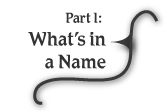Introduction
This section of the webtext is organized by the categories that I argue constitute the anatomy of a definition. These categories were derived from patterns that I noticed during the interview process while listening to how scholars would talk about the terms they chose to use and how they would define those terms.
Additional layers of meaning have also been constructed through the inclusion of both images and transcripts that accompany each audio excerpt. Transcripts provide clarity and reinforce the particular vocabulary used by each scholar. But in addition to a transcript, each clip is paired with an image that the user is invited to view and reflect on while listening to the clip. The images are intended to serve as metaphors, sometimes closely related to the literal content of the clip, other times peripherally related, but at all times intended to extend the surface meaning of the clip and provoke the user to think further about the ideas they are encountering.
A note about listening to the interviews
These interviews, as previously mentioned, were conducted over a three-year period, from May of 2007 to March of 2010. Interviews lasted anywhere from 40 to 70 minutes and were audio recorded. The responses that each contributor provided should be understood in the context of the technological landscape available at the time each interview took place. It would be perfectly understandable if contributors whom I interviewed in 2007 would choose to answer differently (even slightly) if I asked them the same questions today. The responses they provided are valuable in their own right but should be read in the context in which they occurred.
The excerpts included throughout this text were made intentionally short (under 2 minutes or so) to accommodate readers' habits and expectations with regard to web content. This leaves open the possibility that I inadvertently misrepresented a perspective by cropping it out of the larger conversation. While such short clips help focus the point being made to support the larger argument of the piece, they also have the potential of diluting some of the context and nuance in a person’s response. As a result I ask that you be generous listeners and remain aware that the excerpts you are listening to have been taken from larger conversations.
Another caveat is that differences of opinion are apparent in several responses; however, the contributors were never told of such differences nor asked to respond to comments made by the other contributors. Perhaps if such differences were brought to each contributor’s attention, there would be an effort to clarify or amend or reposition. However that was not the case. Certainty and correctness were not what I sought in these interviews so differences of opinion appear without an attempt at resolution.
Finally, one of the difficulties with interviews is that often people respond to questions without repeating key words that are used in asking the question. As a result, at times there are ambiguous references in the interview excerpts that I have tried to account for by including bracketed references in the transcripts and by addressing the subject being discussed in my introduction to each excerpt.
To begin your listening experience, please choose a category from the list to your left.
This section of the webtext is organized by the categories that I argue constitute the anatomy of a definition. These categories were derived from patterns that I noticed during the interview process while listening to how scholars would talk about the terms they chose to use and how they would define those terms.
Additional layers of meaning have also been constructed through the inclusion of both images and transcripts that accompany each audio excerpt. Transcripts provide clarity and reinforce the particular vocabulary used by each scholar. But in addition to a transcript, each clip is paired with an image that the user is invited to view and reflect on while listening to the clip. The images are intended to serve as metaphors, sometimes closely related to the literal content of the clip, other times peripherally related, but at all times intended to extend the surface meaning of the clip and provoke the user to think further about the ideas they are encountering.
A note about listening to the interviews
These interviews, as previously mentioned, were conducted over a three-year period, from May of 2007 to March of 2010. Interviews lasted anywhere from 40 to 70 minutes and were audio recorded. The responses that each contributor provided should be understood in the context of the technological landscape available at the time each interview took place. It would be perfectly understandable if contributors whom I interviewed in 2007 would choose to answer differently (even slightly) if I asked them the same questions today. The responses they provided are valuable in their own right but should be read in the context in which they occurred.
The excerpts included throughout this text were made intentionally short (under 2 minutes or so) to accommodate readers' habits and expectations with regard to web content. This leaves open the possibility that I inadvertently misrepresented a perspective by cropping it out of the larger conversation. While such short clips help focus the point being made to support the larger argument of the piece, they also have the potential of diluting some of the context and nuance in a person’s response. As a result I ask that you be generous listeners and remain aware that the excerpts you are listening to have been taken from larger conversations.
Another caveat is that differences of opinion are apparent in several responses; however, the contributors were never told of such differences nor asked to respond to comments made by the other contributors. Perhaps if such differences were brought to each contributor’s attention, there would be an effort to clarify or amend or reposition. However that was not the case. Certainty and correctness were not what I sought in these interviews so differences of opinion appear without an attempt at resolution.
Finally, one of the difficulties with interviews is that often people respond to questions without repeating key words that are used in asking the question. As a result, at times there are ambiguous references in the interview excerpts that I have tried to account for by including bracketed references in the transcripts and by addressing the subject being discussed in my introduction to each excerpt.
To begin your listening experience, please choose a category from the list to your left.

